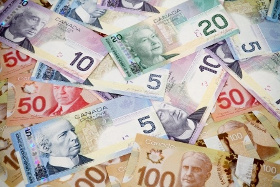The Canadian dollar is strengthening against its US counterpart on Tuesday, buoyed by third-quarter economic growth and rebounding manufacturing activity. But the loonieâs rally was capped by sliding crude oil prices amid uncertainty over the Organization of the Petroleum Exporting Countries (OPEC) and its allies, OPEC+, regarding output in 2021.
According to Statistics Canada, the Canadian economy expanded 8.9% in the third quarter, up from the second quarter’s 11.3% slide. The gross domestic product (GDP) grew at an annualized rate of 40.5% in the July-to-September period, falling short of the median estimate of 47.6%.
On a monthly basis, the national economy advanced 0.8% in September, below the market forecast of 0.9%.
Canada benefited from greater household spending on durable goods, higher real estate investment (30.2%), and exports (14.5%). Consumers purchased more on automobiles and food and beverage services.
The GDP implicit price rose 2.6% in the three months ending in September.
Last month, the IHS Markit manufacturing purchasing managers’ index (PMI) rose to 55.8, up from 55.5 in October. This is the fifth consecutive month of expansion, driven by new orders, output, purchasing activity, and employment levels. Business sentiment remained strong as companies anticipate COVID-19 to pass.
On Monday, the statistics agency reported that producer prices fell 0.4% in October, down from the 0.6% gain in September. The producer price index (PPI) rose 0.7% year-over-year. Raw material prices rose 0.5% in October. Building permits plunged 14.6% in October.
The federal government also unveiled its 2020 fiscal budget, which came as Ottawa reported a $27.6 billion deficit in September. Prime Minister Justin Trudeau and his Liberal government confirmed that the budget gap would widen to more than $300 billion this fiscal year, primarily due to coronavirus-related spending.
Slumping energy prices capped the loonieâs gains. January West Texas Intermediate (WTI) crude oil futures tumbled $0.66, or 1.46%, to $44.68 per barrel at 17:18 GMT on Tuesday on the New York Mercantile Exchange. January natural gas futures slipped $0.018, or 0.62%, to $2.864 per million British thermal units (btu).
Since Canada maintains a current account deficit, the economy depends on exports for growth. With oil and gas being the nationâs top exports, any significant change in prices â high or low â can affect both the economy and the Canadian dollar.
Like other significant countries, Canada is going through a second wave of the coronavirus. On Monday, the Great White North reported nearly 8,000 new infections, raising the total to 381,000 cases, with a death toll of more than 12,000.
The USD/CAD currency pair fell 0.39% to 1.2957, from an opening of 1.3003. The EUR/CAD surged 0.54% to 1.5596, from an opening of 1.5517.
If you have any questions, comments, or opinions regarding the Canadian Dollar, feel free to post them using the commentary form below.

Canadian Dollar Strengthens on Q3 GDP, Manufacturing PMI Growth
More from NewsMore posts in News »


Be First to Comment